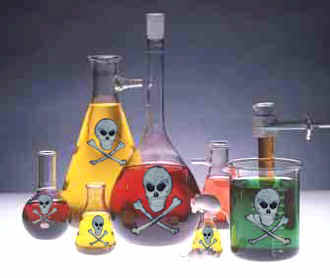
|
As a child, I always
had an interest in chemistry.
I had a chemistry set, and I used to get a kick out of playing
scientist. One day, I got a idea to make poison. I just went thru my
chemicals, picking things at random, and mixing them together with
water. I had no idea what I was doing, I was just having fun pretending
I was making |
|
I decided to test my poison on the parents of one of my friends. I figured he wouldn't mind, since he hated their guts. I was at their house, they were Big Alcoholics, and I put some of my poison in one of the liquor bottles. They drank all the time, so I figured it wouldn't take long. I hung out as long as I could, but finally, I had to go home. Nothing happened, so I figured the poison didn't work, and I forgot about it. |
|
Three weeks later, my friend got to get out of school a few days, it seems his dad was found DEAD on the living room couch. |
|
reader's
comments: Vadim Miesegaes asks: Professor Sneaky Lynx thinks: Linda says: So, let's ask Professor Sneaky Lynx,
resident chemical engineer of The Toiletside Reader... Jamie writes: Simon Macabeus asks: I happened upon your page by accident and began reading your Q&A's about poisons. If cyanide is a CN compound, what happens if you mix methanol with ammonia? If you require CN to produce the compound and ammonia is NH3, thus represents the Nitrogen portion of the equation, and methanol is CH4O, would Methanol work as the Carbon source? Or what about Methyl Hydrate, since it's a derivative of CH4 ? Again, let's ask Professor Sneaky Lynx, resident chemical engineer of The Toiletside Reader... Professor Sneaky Lynx says: Here is what the Master Sneak knows.First of all, Methanol and Methyl Hydrate ARE THE SAME THING! <-- as shown in here. Ammonia and alcohols in general, I don't think that's enough to produce cyanide. (In fact, from my vast knowledgeable brain, you would be way off the mark). You do get the carbon source and the nitrogen source from both compounds, but I think you'd just end up with a lot of ions in solution. (Which would nonetheless be VERY toxic anyway). ABOUT CYANIDE: "Information about cyanide is readily available ANYWHERE, if you know how to even look for your own ass. If you're too stupid to know that, then don't even bother thinking about making cyanide, you'll kill yourself with it. (might be doing the world a favour though)" cyanide , chemical compound containing the cyano group, -CN. Cyanides are salts or esters of hydrogen cyanide (hydrocyanic acid, HCN) formed by replacing the hydrogen with a metal (e.g., sodium or potassium) or a radical (e.g., ammonium or ethyl). The most common and widely used cyanides are those of sodium and potassium; they are often referred to simply as “cyanide.” Both are white, crystalline, chemically active compounds. They are used as insecticides, in making pigments, in metallurgy (e.g., electroplating and case hardening), and in refining gold and silver by the cyanide process. Organic cyanides are called nitriles. The ethyl ester of hydrogen cyanide (CH3CH2CN) is called variously ethyl cyanide, propionitrile, propane nitrile, nitrilopropane, and cyanoethane; propane nitrile is the approved name in the nomenclature system for organic chemistry adopted by the International Union of Pure and Applied Chemistry (IUPAC). Most cyanides are deadly poisons that cause respiratory failure. Symptoms of cyanide poisoning include an odor of bitter almond on the breath, dizziness, convulsions, collapse, and, often, froth on the mouth. In case of cyanide poisoning a doctor should be summoned immediately. If the poison was swallowed, vomiting should be induced. Artificial respiration should be used if needed. Dr. Popeye-X
yells: In other words, |